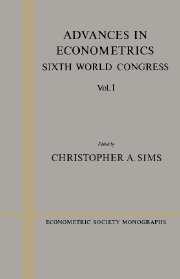5 - Quantile regression, censoring, and the structure of wages
Published online by Cambridge University Press: 05 January 2013
Summary
INTRODUCTION
This chapter develops two empirical applications of quantile regression techniques. The first application examines how the returns to schooling have changed from 1979 to 1987. The second application examines the union relative wage effect in 1987. In both cases our interest is in providing a more detailed description of the conditional distribution of wages.
The returns to schooling application is based on forming schooling-experience cells, calculating various sample quantiles within each cell, and then using a minimum-distance estimator to impose a parametric form on the conditional quantile functions. There is a censoring problem because usual weekly earnings in the Current Population Survey are topcoded at $999. Our framework makes it very easy to apply Powell's (1984, 1986) approach to the censoring problem - we only use the cells for which the sample quantile is below the censoring point. The censoring correction has a substantial effect on the estimates in some cases. The returns to schooling tend to increase as we pass from low to high quantiles, both in 1979 and 1987. The returns are substantially higher in 1987 than 1979, and the change is fairly uniform across the quantiles.
The second application does not lend itself to forming cells since there are close to 40 covariates. A linear programming algorithm is, however, effective. We find, for the more experienced workers, that the union wage effect declines sharply as we go from low to high quantiles. There is a similar pattern for the industry wage effects in several of the durable manufacturing industries. We also generalize the functional form of the quantile regressions by using a Box-Cox transformation. Our algorithm combines linear programming with a one-dimensional search, by appealing to the equivariance of quantiles under monotone transformations.
- Type
- Chapter
- Information
- Advances in EconometricsSixth World Congress, pp. 171 - 210Publisher: Cambridge University PressPrint publication year: 1994
- 126
- Cited by

